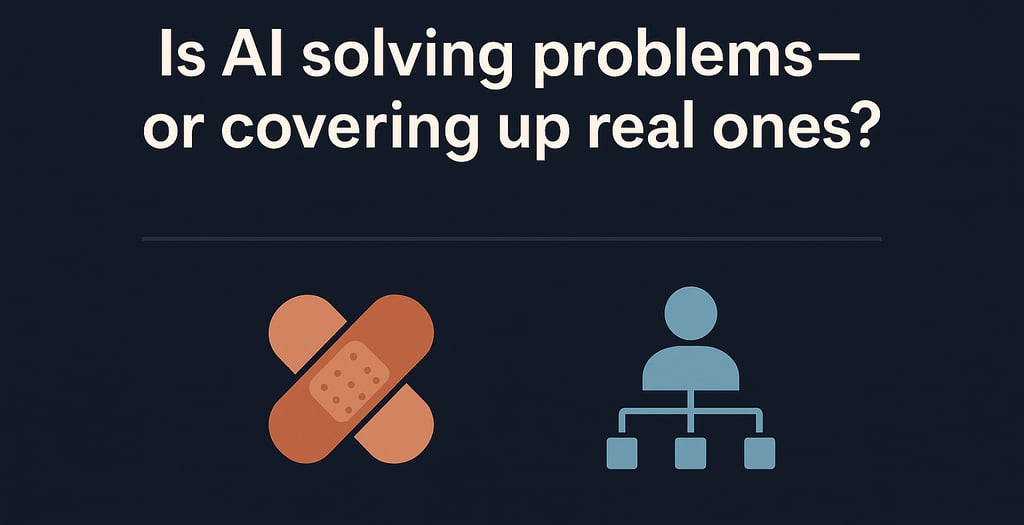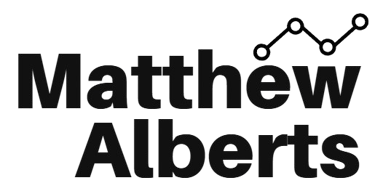Are We Building AI to Solve Problems, or to Avoid Them?
Is AI solving real problems, or quietly hiding them? Across companies, the pattern is familiar: Communication is breaking down, Roles are unclear, Teams are stretched thin, And the response? “Let’s build a bot.” AI gets deployed not as a catalyst for transformation, but as a bandage for dysfunction. Yes, it can summarize, schedule, and automate. But if the real issue is misalignment, fatigue, or unclear ownership… AI won’t fix it. It’ll just hide it. We’re often building agents to manage symptoms, without diagnosing the system. And in the process, we risk optimizing for speed while sacrificing intent.
Matthew Alberts PhD
8/2/20254 min read


There’s a peculiar kind of silence that follows many enterprise AI deployments.
Not the celebratory silence of a system that “just works,” but something more uneasy, an unspoken awareness that while a process has been automated, little else has truly changed.
Across industries, the dominant narrative around artificial intelligence is one of acceleration. Faster response times. Fewer manual tasks. More efficiency. The refrain is familiar: “Let’s build an agent that can handle it.”
But beneath that refrain, a more uncomfortable reality is beginning to surface: AI is often being deployed not to solve our biggest problems, but to avoid confronting them.
The Subtle Shift from Tool to Crutch
AI began its modern enterprise journey as an enhancer, an extension of human capability, a way to relieve people from the tedious and time-consuming. But as organizations grapple with increasingly complex systems and strained resources, that role is changing. Today, many AI systems aren’t augmenting clarity; they’re standing in for it. They’re deployed not at points of innovation, but at points of breakdown. We ask an agent to take notes because no one really owns the follow-up. We launch a chatbot because our documentation is a maze. We build a recommendation engine because decision-making has become paralyzed by noise.It’s not that these tools don’t work, they often do, in isolation. But when success is measured solely by automation rate or reduction in touchpoints, it’s easy to lose sight of a critical truth:
A process made faster is not necessarily made better.
When Automation Masks Misalignment
Consider the origin of most AI projects in large organizations. Rarely do they begin with a crisp strategic objective. Instead, they often emerge from operational friction:
A team struggling to keep up with emails.
A backlog of tasks that never seem to clear.
A request from leadership to “make this more scalable.”
That friction becomes the problem statement. AI becomes the answer. But what if the real issue isn’t speed or volume, but misaligned incentives, fragmented ownership, or unclear roles? What if the friction is pointing to something deeper, something AI, by its very nature, is not equipped to resolve? Deploying automation in these cases isn’t just a missed opportunity. It’s a deflection. It makes the symptoms quieter while allowing the root causes to grow more entrenched.
It’s operational Novocain.
And when the numbness wears off, the system hasn’t improved. It’s simply become harder to diagnose.
The Quiet Cost of “Efficiency”
Organizations rarely stop to measure the opportunity cost of these AI deployments, not in terms of dollars or compute, but in misdirected focus. When your top innovation minds are pulled into building yet another scheduling assistant or workflow bot, what breakthroughs are they not exploring? What deeper transformations are being left on the whiteboard, because all the energy is going into patching what’s broken, instead of asking why it broke in the first place? There is a growing tension between automation and introspection.
The more we automate, the less we seem to pause and reflect.
Ironically, in the pursuit of “freeing up time,” many organizations have built environments where no one actually uses that time to think.
Are We Avoiding the Real Work?
It’s easy to understand why this happens. Addressing the human root of a problem, miscommunication, low engagement, poor process ownership, is hard. It takes time, and trust, and sometimes uncomfortable truth-telling. But these are the conditions where real transformation begins. When we choose to bypass them with automation, we inadvertently hardwire dysfunction into the system. We start optimizing for compliance rather than creativity. We build tools to manage apathy instead of asking what caused it. We reward responsiveness over reflection. And slowly, we stop seeing what’s missing, because everything seems to be working. The reports are cleaner. The meetings have recaps. The alerts fire.
But alignment? Engagement? Purpose?
Those aren’t found in system logs.
A Different Kind of Intelligence
AI has never been about replacing people, it’s about enhancing what people can do. But enhancement requires a foundation. It requires that we’ve already done the work of understanding our systems, our people, and our culture. When that groundwork is skipped, AI becomes reactive.
Tactical.
Shallow.
The irony is that the more powerful our tools become, the more critical our intentions become. Are we building to remove work, or to elevate it? Are we training systems to carry the weight of our inefficiencies, or to reveal them? Are we innovating from courage, or from fatigue? These are not questions for the data science team. They are questions for leadership. Because while AI can do a great many things, it cannot, and will not, set your organizational priorities.
That is still a human act.
The Path Forward
There is a better way. It begins with restraint, not rushing to automate, but choosing to investigate. It continues with alignment, building tools only after we’ve clarified the problem. And it ends with elevation, measuring success not in time saved, but in trust earned, outcomes improved, and capabilities grown. AI can be a force multiplier. But only if it’s multiplying something worth scaling. When deployed with wisdom and intentionality, it does move the needle. It enables teams to think more deeply, act more decisively, and collaborate more meaningfully.
But that outcome isn’t inevitable. It’s earned.
And it begins with a single, unglamorous question:
What is this tool really for?
